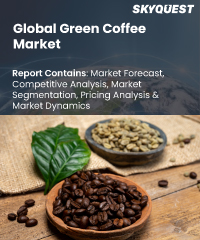
Product ID: SQMIG30G2035

Report ID:
SQMIG30G2035 |
Region:
Global |
Published Date: April, 2024
Pages:
198
|
Tables:
84 |
Figures:
76
Global Green Coffee Market size was valued at USD 36.2 billion in 2022 and is poised to grow from USD 37.99 billion in 2023 to USD 55.92 billion by 2031, growing at a CAGR of 4.95% in the forecast period (2024-2031).
The global green coffee market is projected to witness a significant surge in demand in the coming years. This increased demand can be attributed to the numerous potential health benefits associated with green coffee, including weight loss assistance, blood pressure control, and cholesterol level regulation for individuals with diabetes. Additionally, the market has been fueled by the growing preference for plant-based dietary options and the rising appreciation for specialty coffee varieties. As consumers become more conscious about their health and seek unique, natural, and sustainable choices, green coffee has emerged as a favored option due to its multifaceted advantages. Green coffee contains chlorogenic acid content and antioxidants, which contribute to its ability to help manage diabetes, obesity, and cardiovascular diseases. The modern consumer base is increasingly shifting toward healthier alternatives.
According to a March 2022 article by the World Health Organization, the global obesity rate exceeded one billion people, with an estimated 167 million individuals, both adults and children, projected to become obese in the future. Moreover, the International Diabetic Federation (IDF) predicts that approximately 537 million people aged 20-79 will have diabetes, with numbers expected to reach 643 million by 2030 and 783 million by 2045. Consequently, the growing prevalence of various lifestyle disorders and the potential of green coffee to address them are significant factors that will drive market growth in the upcoming years. Furthermore, the rising popularity of specialty coffee among millennials has contributed to the high demand for green coffee. The younger generation considers specialty coffee to be a premium and healthier product, leading market players to expand their product offerings.
The market growth can also be attributed to the increased demand for Arabica coffee, known for its superior quality and diverse flavors. Arabica coffee, which accounts for approximately 58% of total production, offers a variety of taste profiles, including fruity, sweet, and berry notes. According to a 2021 report by the International Coffee Organization, Arabica and Robusta are the two primary coffee species that have traditionally dominated the global market, with Arabica holding a 58% share and Robusta comprising 42%. Furthermore, market expansion is expected to be accelerated by initiatives from public and private organizations involved in coffee production and export. For example, the Government of India launched the Integrated Coffee Development Project Scheme (ICDP) in September 2019, aimed at improving coffee varieties, enhancing production, providing research and development support to coffee producers, and strengthening the domestic market. The platform aims to address poverty among smallholder coffee farmers and promote sustainability while upholding high environmental, social, and governance standards. Technological advancements and support from governmental entities can further bolster market growth.
US Green Coffee Market is poised to grow at sustainable CAGR for the next forecast year
Our industry expert will work with you to provide you with customized data in a short amount of time.
REQUEST FREE CUSTOMIZATIONWant to customize this report? This report can be personalized according to your needs. Our analysts and industry experts will work directly with you to understand your requirements and provide you with customized data in a short amount of time. We offer $1000 worth of FREE customization at the time of purchase.

Product ID: SQMIG30G2035